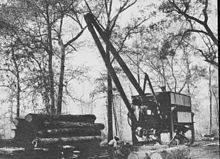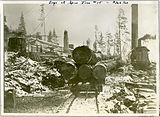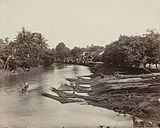Logging



Logging is the process of cutting, processing, and moving trees to a location for transport. It may include skidding, on-site processing, and loading of trees or logs onto trucks[1] or skeleton cars. In forestry, the term logging is sometimes used narrowly to describe the logistics of moving wood from the stump to somewhere outside the forest, usually a sawmill or a lumber yard. In common usage, however, the term may cover a range of forestry or silviculture activities.
Logging is the beginning of a supply chain that provides raw material for many products societies worldwide use for housing, construction, energy, and consumer paper products. Logging systems are also used to manage forests, reduce the risk of wildfires, and restore ecosystem functions,[2] though their efficiency for these purposes has been challenged.[3]
Logging frequently has negative impacts. The harvesting procedure itself may be illegal, including the use of corrupt means to gain access to forests; extraction without permission or from a protected area; the cutting of protected species; or the extraction of timber in excess of agreed limits.[4] It may involve the so-called "timber mafia".[5][6] Excess logging can lead to irreparable harm to ecosystems, such as deforestation and biodiversity loss.[7][8] Infrastructure for logging can also lead to other environmental degradation. These negative environmental impacts can lead to environmental conflict.[7][8] Additionally, there is significant occupational injury risk involved in logging.
Logging can take many formats. Clearcutting (or "block cutting") is not necessarily considered a type of logging but a harvesting or silviculture method. Cutting trees with the highest value and leaving those with lower value, often diseased or malformed trees, is referred to as high grading. It is sometimes called selective logging, and confused with selection cutting, the practice of managing stands by harvesting a proportion of trees.[9] Logging usually refers to above-ground forestry logging. Submerged forests exist on land that has been flooded by damming to create reservoirs. Harvesting trees from forests submerged by flooding or dam creation is called underwater logging, a form of timber recovery.[10]
Clearcutting
[edit]Clearcutting, or clearfelling, is a method of harvesting that removes essentially all the standing trees in a selected area. Depending on management objectives, a clearcut may or may not have reserve trees left to attain goals other than regeneration,[1] including wildlife habitat management, mitigation of potential erosion or water quality concerns. Silviculture objectives for clearcutting, (for example, healthy regeneration of new trees on the site) and a focus on forestry distinguish it from deforestation. Other methods include shelterwood cutting, group selective, single selective, seed-tree cutting, patch cut, and retention cutting.[citation needed]
Logging methods
[edit]
The above operations can be carried out by different methods, of which the following three are considered industrial methods:
Tree-length logging / stem-only harvesting
[edit]Trees are felled and then delimbed and topped at the stump. The log is then transported to the landing, where it is bucked and loaded on a truck. This leaves the slash (and the nutrients it contains) in the cut area, where it must be further treated if wild land fires are of concern.[citation needed]
Whole-tree logging
[edit]

Trees and plants are felled and transported to the roadside with top and limbs intact. There have been advancements to the process which now allows a logger or harvester to cut the tree down, top, and delimb a tree in the same process. This ability is due to the advancement in the style felling head that can be used. The trees are then delimbed, topped, and bucked at the landing. This method requires that slash be treated at the landing. In areas with access to cogeneration facilities, the slash can be chipped and used for the production of electricity or heat. Full-tree harvesting also refers to utilization of the entire tree including branches and tops.[11] This technique removes both nutrients and soil cover from the site and so can be harmful to the long-term health of the area if no further action is taken, however, depending on the species, many of the limbs are often broken off in handling so the result may not be as different from tree-length logging as it might seem.[citation needed]
Cut-to-length logging
[edit]Cut-to-length logging is the process of felling, delimbing, bucking, and sorting (pulpwood, sawlog, etc.) at the stump area, leaving limbs and tops in the forest. Mechanical harvesters fell the tree, delimb, and buck it, and place the resulting logs in bunks to be brought to the landing by a skidder or forwarder. This method is routinely available for trees up to 900 mm (35 in) in diameter.
Transporting logs
[edit]
Logging methods have changed over time, driven by advancements in transporting timber from remote areas to markets. These shifts fall into three main eras: the manual logging era before the 1880s, the railroad logging era from the 1880s to World War II, and the modern mechanized era that began after the war.[12]
Pre-1880s: Pre-Industrial Era
[edit]In the early days, felled logs were transported using simple methods such as rivers to float tree trunks downstream to sawmills or paper mills. This practice, known as log driving or timber rafting, was the cheapest and most common. Some logs, due to high resin content, would sink and were known as deadheads. Logs were also moved with high-wheel loaders, a set of wheels over ten feet tall, initially pulled by oxen.[13]
1880s to World War II: Railroad Logging Era
[edit]As the logging industry expanded, the 1880s saw the introduction of mechanized equipment like railroads and steam-powered machinery, marking the beginning of the railroad logging era. Logs were moved more efficiently by railroads built into remote forest areas, often supported by additional methods like high-wheel loaders, tractors and log flumes.[14] The largest high-wheel loader, the "Bunyan Buggie," was built in 1960 for service in California, featuring wheels 24 feet (7.3 m) high.[15]
Post-World War II: Modern Mechanized Logging
[edit]After World War II, mechanized logging equipment, including chainsaws, diesel trucks, and Caterpillar tractors, transformed the logging industry, making railroad-based logging obsolete. With the advent of these tools, transporting logs became more efficient as new roads were constructed to access remote forests. However, in protected areas like United States National Forests and designated wilderness zones, road building has been restricted to minimize environmental impacts such as erosion in riparian zones.
Today, heavy machinery such as yarders and skyline systems are used to gather logs from steep terrain, while helicopters are used for heli-logging to minimize environmental impact.[16] Less common forms of logging, like horse logging and the use of oxen, still exist but are mostly superseded.[17]
Safety considerations
[edit]Logging is a dangerous occupation. In the United States, it has consistently been one of the most hazardous industries and was recognized by the National Institute for Occupational Safety and Health (NIOSH) as a priority industry sector in the National Occupational Research Agenda (NORA) to identify and provide intervention strategies regarding occupational health and safety issues.[18][2]
In 2008, the logging industry employed 86,000 workers and accounted for 93 deaths. This resulted in a fatality rate of 108.1 deaths per 100,000 workers that year. This rate is over 30 times higher than the overall fatality rate.[19] Forestry/logging-related injuries (fatal and non-fatal) are often difficult to track through formal reporting mechanisms. Thus, some programs have begun to monitor injuries through publicly available reports such as news media.[20] The logging industry experiences the highest fatality rate of 23.2 per 100,000 full-time equivalent (FTE) workers and a non-fatal incident rate of 8.5 per 100 FTE workers. The most common type of injuries or illnesses at work include musculoskeletal disorders (MSDs), which include an extensive list of "inflammatory and degenerative conditions affecting the muscles, tendons, ligaments, joints, peripheral nerves, and supporting blood vessels."[21] Loggers work with heavy, moving weights, and use tools such as chainsaws and heavy equipment on uneven and sometimes steep or unstable terrain. Loggers also deal with severe environmental conditions, such as inclement weather and severe heat or cold. An injured logger is often far from professional emergency treatment.[citation needed]
Traditionally, the cry of "Timber!" developed as a warning alerting fellow workers in an area that a tree is being felled, so they should be alert to avoid being struck. The term "widowmaker" for timber, typically a limb or branch that is no longer attached to a tree, but is still in the canopy either wedged in a crotch, tangled in other limbs, or miraculously balanced on another limb demonstrates another emphasis on situational awareness as a safety principle.[22]
In British Columbia, Canada, the BC Forest Safety Council was created in September 2004 as a not-for-profit society dedicated to promoting safety in the forest sector. It works with employers, workers, contractors, and government agencies to implement fundamental changes necessary to make it safer to earn a living in forestry.[23]
The risks experienced in logging operations can be somewhat reduced, where conditions permit, by the use of mechanical tree harvesters, skidders, and forwarders.[24]
-
Horse Logging in Wales
-
Log transportation by rail in British Columbia in 1920
-
Bucked old growth wood in Finland
-
Mechanical harvester at work
-
Hardwood logs transported down the Suriname River in South America in 1955
-
Logs in Mexico in 2018
See also
[edit]References
[edit]- ^ a b Society of American Foresters, 1998. Dictionary of Forestry. Archived 2011-07-25 at the Wayback Machine
- ^ a b Keifer, Matthew; Casanova, Vanessa; Garland, John; Smidt, Mathew; Struttmann, Tim (2019-04-03). "Foreword by the Editor-in-Chief and Guest Editors". Journal of Agromedicine. 24 (2): 119–120. doi:10.1080/1059924X.2019.1596697. ISSN 1059-924X. PMID 30890041. S2CID 150081506.
- ^ 'Logging emits three times as much carbon dioxide into the atmosphere per acre as wildfire alone. Most of the tree parts unusable for lumber – the branches, tops, bark and sawdust from milling – are burned for energy, sending large amounts of carbon into the atmosphere. In contrast, wildfire releases a surprisingly small amount of the carbon in trees, less than 2 percent. Logging in U.S. forests is now responsible for as much annual greenhouse gas emissions as burning coal.' Chad Hanson, Michael Dorsey, 'The Case Against Commercial Logging in Wildfire-Prone Forests,' New York Times 30 July 2022.
- ^ Illegal Logging.Info
- ^ Virginia Tech: Dealing with Timber Theft Archived 2008-10-17 at the Wayback Machine
- ^ msnbc.com – Guilty pleas in cedar tree theft September 23, 2008 [dead link]
- ^ a b Putz, Francis E.; Dykstra, Dennis P.; Heinrich, Rudolf (2000). "Why Poor Logging Practices Persist in the Tropics". Conservation Biology. 14 (4): 951–956. Bibcode:2000ConBi..14..951P. doi:10.1046/j.1523-1739.2000.99137.x. ISSN 0888-8892. JSTOR 2641994. S2CID 40156577.
- ^ a b "Environmental hazards from logging". The Encyclopedia of World Probems & Human Potential. 2020-10-04.
- ^ Forest Matters: Just Say No to High Grading page 8 Archived September 26, 2007, at the Wayback Machine
- ^ "Triton Logging". Archived from the original on 2011-02-08. Retrieved 2011-04-25.
- ^ Weatherspoon, C. Phillip. "Fire-Silviculture Relationships in Sierra Forests" (PDF). Redding, California: United States Forest Service. pp. 1167–1176. Archived from the original (PDF) on September 26, 2006.
- ^ "Lecture - Hank Johnston". Sierra Historic Sites Association. April 27, 1980. Retrieved September 29, 2024.
- ^ "Wanted An-Inventor!" Popular Mechanics Monthly, July 1930, pp. 66–70, see p. 67 middle photo
- ^ "A look back at the history of the Valley's log flumes". ABC 30 (KFSN). Fresno, California. Retrieved November 19, 2022.
- ^ "Huge Logging Tractor Moves on Wheels 24 Feet High." Popular Science, June 1960, pp. 96–98.
- ^ Helicopter logging or Heli-logging Archived 2009-06-04 at the Wayback Machine, Forestry.com
- ^ Animal logging in the US South and its application in the developing countries, FAO
- ^ "CDC – NORA Agriculture, Forestry and Fishing Sector Council". www.cdc.gov. 2019-02-10. Retrieved 2019-03-14.
- ^ "NIOSH Logging Safety". United States National Institute for Occupational Safety and Health. Retrieved 2010-04-19.
- ^ Weichelt, Bryan; Gorucu, Serap (2018-02-17). "Supplemental surveillance: a review of 2015 and 2016 agricultural injury data from news reports on AgInjuryNews.org". Injury Prevention. 25 (3): injuryprev–2017–042671. doi:10.1136/injuryprev-2017-042671. ISSN 1353-8047. PMID 29386372. S2CID 3371442.
- ^ Rodriguez, Anabel; Casanova, Vanessa; Levin, Jeffrey L.; Porras, David Gimeno Ruiz de; Douphrate, David I. (2019-04-03). "Work-Related Musculoskeletal Symptoms among Loggers in the Ark-La-Tex Region". Journal of Agromedicine. 24 (2): 167–176. doi:10.1080/1059924X.2019.1567423. ISSN 1059-924X. PMC 7008449. PMID 30624156.
- ^ Love, Joseph. "Avoiding Widowmakers - Grit". www.grit.com. Retrieved 2024-02-27.
- ^ BC Forest Safety Council
- ^ "Forestry: Guide to Managing Risks of Timber Harvesting Operations". Trove. Retrieved 2023-04-20.
Further reading
[edit]- Bryant, Ralph Clement (1913). Logging; the principles and general methods of operation in the United States. New York: J. Wiley & Sons.
- Costa, F.; Magnusson, W. (2002). "Selective effects on abundance, diversity, and composition of tropical understory herbs". Ecological Applications. 12 (3): 807–819. doi:10.1890/1051-0761(2002)012[0807:SLEOAD]2.0.CO;2.
- Pinard, M. A.; Putz, F. E. (1996). "Retaining forest biomass by reducing logging damage". Biotropica. 28 (3): 278–295. Bibcode:1996Biotr..28..278P. doi:10.2307/2389193. JSTOR 2389193.
- Putz, F.; Sist, P.; Frederickson, T.; Dykstra, D. (2008). "Reduced-impact logging: challenges and opportunities". Forest Ecology & Management. 256 (7): 1427–1433. doi:10.1016/j.foreco.2008.03.036. Archived from the original on 2021-01-26. Retrieved 2018-04-29.
- Shukla, J.; Sellers, P.; Nobre, C. (1990). "Amazon deforestation and climate change". Science. 247 (7): 1322–1325. Bibcode:1990Sci...247.1322S. doi:10.1126/science.247.4948.1322. hdl:10535/2838. PMID 17843795. S2CID 8361418.
- Sokal, R. R.; Gurevitch, J.; Brown, K. A. (2004). "Long-term impacts of logging on forest diversity in Madagascar". PNAS. 101 (16): 6045–6049. Bibcode:2004PNAS..101.6045B. doi:10.1073/pnas.0401456101. PMC 395920. PMID 15067121.
External links
[edit]This section's use of external links may not follow Wikipedia's policies or guidelines. (May 2018) |
- National Institute for Occupational Safety and Health – Logging safety
- Publications on timber harvesting in Minnesota, US. Many are applicable elsewhere.
- EIA forest reports: Investigations into illegal logging.
- EIA in the USA Reports and info.
- Logging in Reynoldston, NY 1870–1930, northern foothills of the Adirondack Mountains
- Life in Logging Camps in Reynoldston NY 1870–1930
- BC Forest Safety Council
- Pictorial history of logging from 1880–1920
- Naturally:wood Sustainable Forest Management
- Logging in North Vancouver in the 1910s – A visual history from the UBC Library Digital Collections
- Industries and Occupation Photographs in the Pacific Northwest – Logging and Lumber Mining Photographs from the University of Washington Library
- Kinsey Brothers Photography of the Lumber Industry in the Pacific Northwest – University of Washington Library
- Man to Machine: Logging in the Pacific Northwest – University of Washington Library
- North American forest industry Archived 2016-01-23 at the Wayback Machine online information portal








